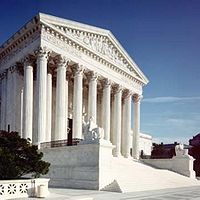Federal Judiciary Act Of 1789
 From Conservapedia
From Conservapedia 
The founders of the new nation believed that the establishment of a national judiciary was one of their most important tasks. Yet Article III of the Constitution of the United States, the provision that deals with the judiciary branch of government, is markedly smaller than Articles I and II, which created the legislative and executive branches.
Background[edit]
The generality of Article III of the Constitution raised questions that Congress had to address in the Federal Judiciary Act of 1789. These questions had no easy answers, and the solutions to them were achieved politically. The First Congress decided that it could regulate the jurisdiction of all Federal courts, and in the Judiciary Act of 1789, Congress established with great particularity a limited jurisdiction for the district and circuit courts, gave the Supreme Court the original jurisdiction provided for in the Constitution, and granted the Court appellate jurisdiction in cases from the Federal circuit courts and from the state courts where those courts rulings had rejected Federal claims. The decision to grant Federal courts a jurisdiction more restrictive than that allowed by the Constitution represented a recognition by the Congress that the people of the United States would not find a full-blown Federal court system palatable at that time.
For nearly all of the next century the judicial system remained essentially as established by the Judiciary Act of 1789. Only after the country had expanded across a continent and had been torn apart by civil war were major changes made. A separate tier of appellate circuit courts created in 1891 removed the burden of circuit-riding from the shoulders of the Supreme Court justices, but otherwise left intact the judicial structure.
With minor adjustments, it is the same system we have today. Congress has continued to build on the interpretation of the drafters of the first judiciary act in exercising a discretionary power to expand or restrict Federal court jurisdiction. While opinions as to what constitutes the proper balance of Federal and state concerns vary no less today than they did two centuries ago, the fact that today’s Federal court system closely resembles the one created in 1789 suggests that the First Congress performed its job admirably.
Judicial review[edit]
Section 13 of the Judiciary Act grants the courts the power to issue writs of mandamus, even though no such constitutional authority exists. In the case of Marbury v. Madison, the court declared this section unconstitutional as Congress is not empowered to amend the Constitution.[1][2][3]
Even though the court did agree that a writ of mandamus was the correct solution to the issue, the court realized that the constitution had not empowered them to exercise such action.[4][5]
References[edit]
- ↑ Why Politics Matters: An Introduction to Political Science
- ↑ Inside Constitutional Law: What Matters and Why
- ↑ Encyclopedia of U.S. Political History
- ↑ Judicial Jurisdiction: A Reference Guide to the United States Constitution
- ↑ The Supreme Court of the United States: A Student Companion
Categories: [United States Law] [American State Papers]
↧ Download as ZWI file | Last modified: 02/28/2023 19:40:45 | 8 views
☰ Source: https://www.conservapedia.com/Federal_Judiciary_Act_of_1789 | License: CC BY-SA 3.0
 ZWI signed:
ZWI signed: KSF
KSF